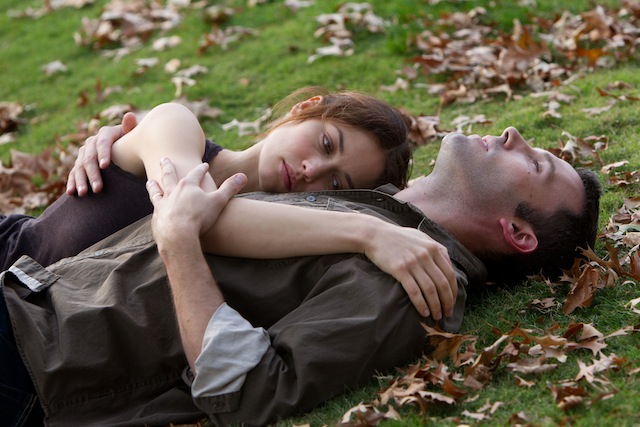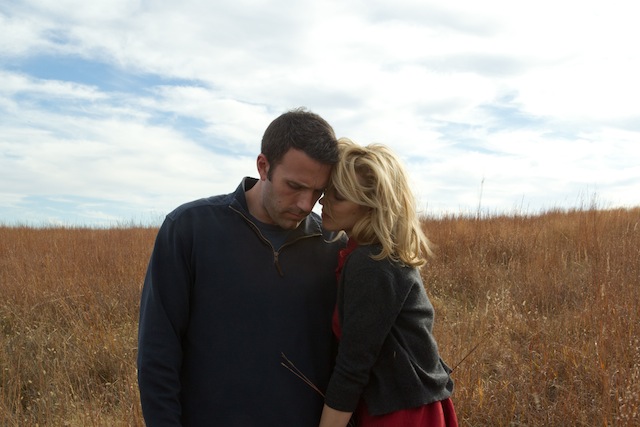CHICAGO – In anticipation of the scariest week of the year, HollywoodChicago.com launches its 2024 Movie Gifts series, which will suggest DVDs and collections for holiday giving.
Terrence Malick’s ‘To the Wonder’ Nearly Drowns in its Own Beauty
 Rating: 3.0/5.0 |
CHICAGO – Deservedly renowned as one of our greatest living filmmakers, Terrence Malick has a reputation for taking his time with each project. He won’t make a picture unless he feels a burning desire to make it, and will put directing on the back burner for two decades, if necessary, in order to pursue other interests. He’s never made what could be conceivably considered a minor work—until now.
At first, it struck me as exciting news that Malick’s revitalized creative juices on the heels of his breathtaking 2011 triumph, “The Tree of Life,” had inspired him to tackle three new projects in a row. But when faced with “To the Wonder,” the first chapter of his post-“Life” trilogy, it appears that Malick and his ever-growing team of editors would’ve benefited from more time in the cutting room. For an artist of such staggering ambition, there is very little on the screen that could be considered potently provocative. Instead, there’s lots of twirling and sniffling and “all things shining.”
Even in his early masterpieces, “Badlands” and “Days of Heaven,” Malick favored wide-eyed female protagonists whose stories unfolded in the past tense. There was a bittersweet tinge to their voices as they recalled the vivid memories that flooded the screen with heightened immediacy. Yet whereas those films actively involved the viewer in the characters’ cherished reminiscence, “Wonder” never earns the audience’s investment. It’s too busy wowing us with gorgeous imagery to linger long enough for individual moments to deliver palpable impact. Some viewers have praised the film for focusing its story on a linear narrative devoid of lengthy abstractions, but I’d hardly call that a praise-worthy achievement. The most spellbinding stretch in “Tree of Life” was the extended sequence depicting the evolution of the cosmos, which was preceded by a grieving mother looking to the heavens, wondering how god could’ve allowed her son to die. This was absolutely perfect framing for this sequence, evoking the earth-shattering moments that cause us to ponder the meaning of existence. Nothing in “Wonder” comes anywhere near rivaling the audacity and unbridled ecstasy of that scene, but then again, neither has any film in the last decade. What it does offer is bountiful narration recited by a Ukrainian woman, Marina (Olga Kurylenko), one of four pivotal characters experiencing a crisis of faith.

Olga Kurylenko and Ben Affleck star in Terrence Malick’s To the Wonder.
Photo credit: Magnolia Pictures
Despite the top-billing of Hollywood golden boy Ben Affleck, the star of “Wonder” is clearly Kurylenko, since she receives the majority of screen time and (offscreen) dialogue. It’s nice to see the model-turned-actress cast as something other than one-note eye candy, though viewers merely seeking eye candy will feel they’ve gotten their money’s worth. A great many shots consist solely of Kurylenko frolicking through fields with childlike abandon, though it is refreshing in this technological era to see characters take such exuberant pleasure in the outdoors (it’s initially jarring to see Malick’s signature style imposed on the modern age of iPhones and Skype).
After falling for an American (Affleck), identified in the production notes as “Neil,” during his trip to Europe, Marina is whisked to his home in the flatlands of Oklahoma to start a new life with her young daughter (Tatiana Chiline). This quaint setting is distressingly dismal in comparison to the dazzling early sequences of Neil and Marina paying a visit to the majestic commune, Mont Saint-Michel, dubbed in France as “the Wonder.” There’s a wonderful moment when the couple stroll along the beach, as the waterlogged sand ripples beneath their feet, proving to be as tenuous in its consistency as the lovers’ connection. Eventually the tide will come in on the beach, and on their relationship as well. Expired visas and old flames threaten to dissolve the couple’s dream of a future together, but the precise cause of the rupture in their love is anyone’s guess. With only a half-dozen lines and an oft-obscured face, Affleck registers as a maddening cipher. The actor has never been more wooden onscreen, but it’s not his fault. Malick gives him no opportunity to leave any semblance of an impression, aside from a few volatile moments of rage.
In recent interviews, Kurylenko voiced her frustration that Malick cut many of her meatiest scenes which would’ve provided audiences with a much more complex and compelling portrait of her character. Much of Marina’s alleged “hysteria” was left on the cutting room floor, while the fiery altercations between her and Neil are rendered entirely silent in the final cut. Part of Malick’s genius has been his ability to tell stories through mood and nuance rather than words, but this time, the story becomes submerged to the point of incoherence. It’s obvious what’s happening in the narrative, but the question of why remains confounding. Why is Neil so frightened of intimacy and why can’t he accept the life he’s begun to forge with Marina and her adorable girl? Malick doesn’t have any interest in providing answers to these questions, and in his wonderful final review, Roger Ebert argues that audiences have no need for them. Kurylenko does manage to convey her character’s aching sense of bewilderment, whether she’s standing in a metaphorical intersection or encountering her old friend (played in an all-too-brief cameo by Romina Mondello), who urges her to leave her American prison and embrace life’s untapped possibilities. There are some intriguing links that can be made between the couple’s waning passions and the growing doubt that torments a priest (Javier Bardem), though much of the intrigue is left unrealized.

Ben Affleck and Rachel McAdams star in Terrence Malick’s To the Wonder.
Photo credit: Magnolia Pictures
The spiritual struggle endured by the characters in “Wonder” is undoubtedly shared by the family in “Tree of Life.” In fact, “Wonder” could easily be interpreted as an extended coda to “Life,” considering how identical the films are—both thematically and stylistically (the radiant Rachel McAdams materializes just long enough to bear an eerie resemblance to Jessica Chastain). Malick even utilizes footage from “Life” in “Wonder” (credited in the end titles), as well as the ominous tolling bell that sounds during especially meditative passages. As the director distances himself further and further from dialogue-driven narratives, his films have begun to resemble epic prayers requiring the audience to embrace each scene as if were the next step in a guided meditation. This approach worked astonishingly well in “The Thin Red Line,” “The New World” and especially in “The Tree of Life,” but those pictures had a depth that this film ultimately lacks. It’s the first Malick film that feels like a half-realized sketch rather than a grand opus. What makes it worth recommending, despite its many shortcomings, is the usual wealth of freeze frame-worthy sights captured by master cinematographer Emmanuel Lubezski. It’s the singular beauty of his work, combined with the delirious editing by a quintet including longtime Malick collaborator Mark Yoshikawa, that truly nails the heartache of a temporary romantic union comprised of fleeting images that one wishes would last an eternity. “Wonder” certainly held my attention, but I never fell under its spell. It’s the first Malick film that failed to fill me with an intense desire to see it again.
 | By MATT FAGERHOLM |


